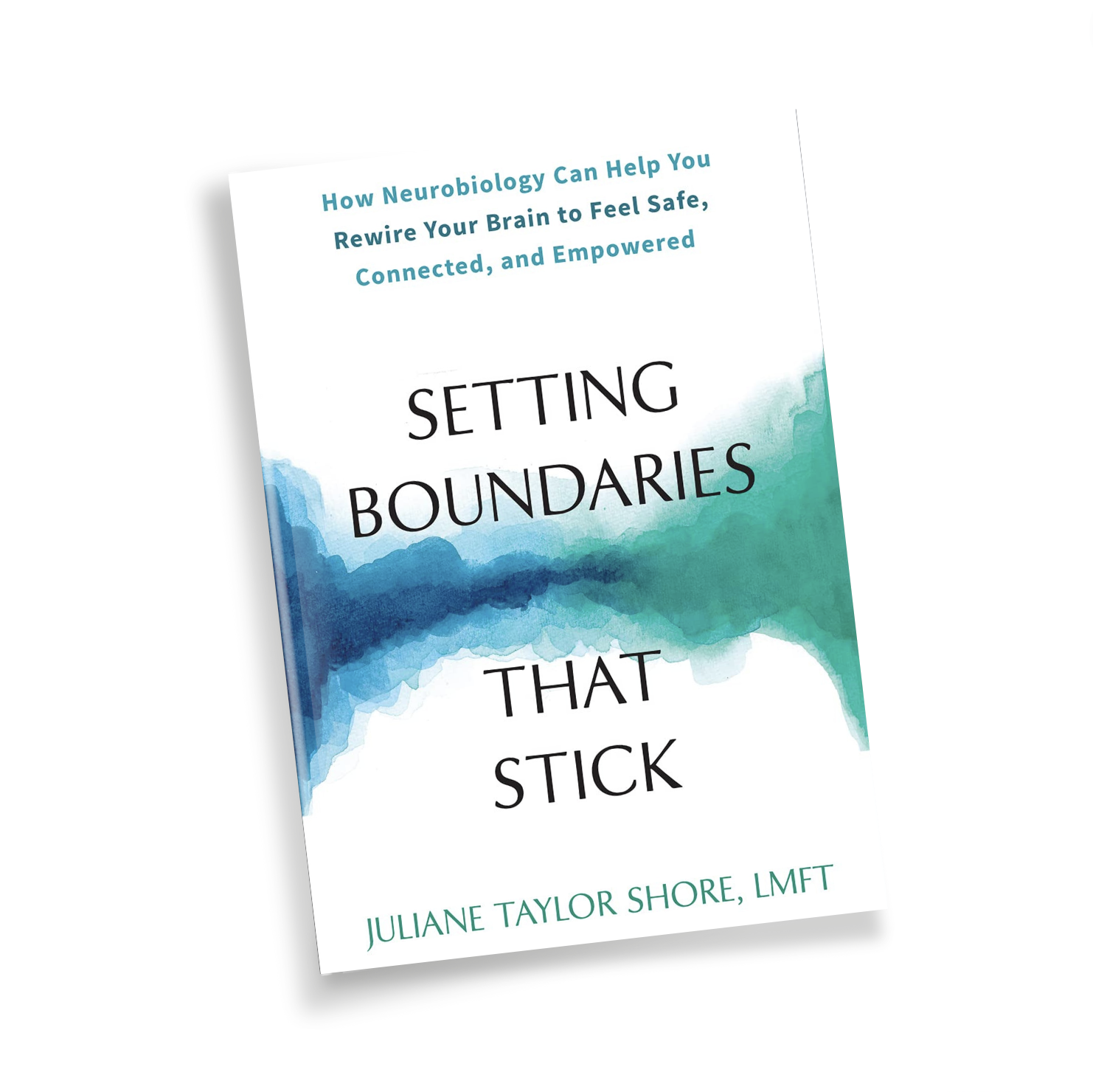Setting Boundaries That Stick
How Neurobiology Can Help You Rewire Your Brain to Feel Safe, Connected, and Empowered
Now Available!
This book looks at boundaries as both internal and relational. Your amazing brain is capable of connection with others, creativity, and nuanced complex functioning when you feel protected and safe enough.
It’s just as important to grow your trust in yourself, treat yourself like you are worthy of protection and kindness, and create psychological safety for yourself, as it is to communicate with others clearly about what is and is not okay with you.
This book is filled with practices that will support you to think deeply about what boundaries are right for you and give you steps, practices, and tools to use on the inside (between you and you) to support you in living up to those boundaries.
Order your copy today!
About the Book
Do you set boundaries that you stick to? Do you ever have trouble knowing what feels good to you and what doesn’t? Do you trust yourself to be kind to yourself and others simultaneously?
You may be wondering about boundaries because you want to trust yourself and feel empowered in more areas of your life. You may have picked it up because it seems hard to feel deeply connected to other people, and truly honor your own needs at the same time. You may want to learn how to respond to others from your best self, rather than just react at the mercy of others’ behavior. To experience life fully, you probably already know that a working set of boundaries will help.
Welcome. No matter what kind of struggles you’ve had in the past, this book and the tools it offers will help you discover, create, communicate, and hold your boundaries.
To set boundaries that stick, learning to work with your brain is essential. The strategies Jules shares utilize discoveries in neurobiology and how our brains and bodies work in relationships. She found these strategies because she needed them in her own life, and needed to help her clients work more effectively with their own boundaries and brains, too.
In this book, Jules introduces a six-step process for setting healthy boundaries. When you start to experiment with the steps, you may find your own areas of difficulty. Treat each emotional pang as a thread that leads you into your inner landscape, you will find the spaces in you that need healing and care there. You will do boundary work in your inner world, as well as in your outer world. You will reflect on how you learned to connect with others and will strengthen your internal boundaries, so you can set boundaries with other people more clearly and kindly.
Four Kinds of Boundaries
-
An external boundary is your ability to define for yourself what is and is not okay with you, and act in accordance with that awareness.
-
A psychological boundary refers to a kind of an inner boundary that separates your mind from other people’s minds inside your own head. It keeps your mind protected from the minds of others, and protects their mind from yours too.
-
The containing boundary is an inner boundary that keeps you aligned with your personal integrity and how you want to behave in relationships.
-
The physical boundary is both internal and external. This is the relative safety of your body at any moment. It prompts you to take in relative safety when that is present, and to increase your external boundaries to align with what your body needs to feel safe in various situations.
Jules had been thinking about boundaries for years, in her many discussions with other clinicians, clients and friends in her life, in reading advice from others, and somehow it didn’t really feel like she was finding a map that helped her come into her relationship with herself enough to know what the right kind of boundaries would be right for her.
In her bones, it felt like that old AA saying was true: Clear is kind, unclear is unkind. But clear about what? Did she need others to behave in specific ways for her to feel emotionally safe enough or was that part more up to her? What about being courageous in how she talked to her loved ones? Did boundaries help make courage and vulnerability more possible? What about setting boundaries with herself? Is that the same kind of work inside as we do on the outside?
These questions had been floating around in her life and in many of her client’s lives for years. Then, a colleague of hers asked her to be on their podcast. She sat with Sue Marriott and Ann Kelley before recording and we chatted about what I might talk about on the show. They had asked her to be part of their podcast because of her history with teaching interpersonal neurobiology, but they hadn’t honed in on our subject matter yet. The chatted about memory reconsolidation, grief, and how she had been thinking about psychological and containing boundary work inside her own life, as well as with her clients. Sue and Ann decided that the boundary work she described would be fun to chat about, and so in 2018 they recorded an episode on Therapist Uncensored called How Boundaries Actually Bring Us Closer Together.
In 2021, an editor from New Harbinger approached Jules because she had heard a replay of that podcast. She wondered if Jules would be interested in turning her ideas about boundaries into a book.
We were in the middle of a pandemic at that point, Jules had taken a sabbatical from her practice (IPNB Psychotherapy of Austin) in order to pursue more research and writing on the mentalization neural network (and surprise! teach her daughter first grade), and she began developing a psychological boundary practice based on that research. Jules had also been creating a containing boundary practice that was an interweaving of experiential work, mindfulness practices, neuroscience discoveries in self-compassion, and values work that was inspired by Brené Brown’s podcast. It was the episode where she was interviewing Jim Collins about finding value words.
Alongside all this, for years in couples work Jules had been slowly growing a teaching of what she now calls the six steps to setting an external boundary. The seeds for what has become the six steps were laid down for me by her mentor, Carol Middelberg, many years ago, and they have expanded through the years through discussions with clients and students.
In 2020, Jules teamed up with Therapy Wisdom and created a training about helping the brain experience deeper safety through boundary work. She wove together the physical boundary work she had been doing with those who had been recovering from trauma, which was largely inspired by her training as a Somatic Experiencing Practitioner, together with the other three boundaries. This course for clinicians helped her solidify her thinking about how all of these boundaries are interwoven to increase self-trust and psychological safety.
So, when Jennye from New Harbinger went to Jules to ask if she was interested in writing a book about boundaries, she thought that it might be time to put all of these thoughts together in one place. Jules offered their team a map of a potential book and two years later the book was written (thanks to amazing editing help), and Jules is sending this thing out there in the hopes that it might help some people. Writing this book has helped Jules get more clear in her thinking and practices, and she does these practices regularly alongside any one else who reads and uses this book.
Jules believes we are all in this bumbly human thing together, and she is so grateful to all of those who have helped her, taught her, challenged her, loved her, inspired her, invited her, and pushed her.
Setting Boundaries That Stick: The Story Behind the Book
What is a Healthy Boundary?
Jules does not believe that she, nor any other person, can tell you what health is for you.
You can think of boundaries as being on a spectrum: one end is rigid, and the other end is porous.
On the rigid side, very little information—in the form of feelings, thoughts, and ideas from other people—comes in. Likewise, very little of your feelings, thoughts and ideas go out toward others.
On the porous side, a whole lot of information goes out—you share your feelings, thoughts, and ideas liberally—and a whole lot comes in. You easily take in other people’s feelings, thoughts, and ideas as true.
There is no particular spot on the spectrum, or a particular behavior or rule, that defines healthy boundaries. Rather, she likes to define healthy boundaries in terms of internal flexibility and responsiveness. There are times when you will know that a more rigid boundary is best, and times when you’ll know a more porous boundary is best.
For too long, the field of psychology has aligned definitions of health with white, male, financially privileged, western norms. For many (or even most), real health and authenticity will fall outside those parameters. Jules knows that the answer for what is healthy for you lies inside of you, waiting for you to discover it and trust yourself enough to live bravely into that truth.
It’s crucial to recognize that boundaries are going to signify different things to each of us based on our identities.
Our positions and locations socially, our cultural identities, skin colors, sexual orientations, physical abilities, genders, and many other factors all play a role in how rigid or porous our boundaries are at any given time—and how we interpret the boundaries of others. For example, different cultures have their own norms around physical boundaries and physical touch. The same is true of emotional expression and contact. A fairly middle-ground sense of a containing boundary in one culture might seem extremely rigid, buttoned-up, or inexpressive in the context of another. As you move from one country to another, one space to another, or one group of people to another, you may sense yourself naturally shifting in response to the cultural expectations and values of the place you are in. It’s also true that asserting boundaries is safer for some people than for others due to differing levels of privilege. She urges you to trust your gut.










